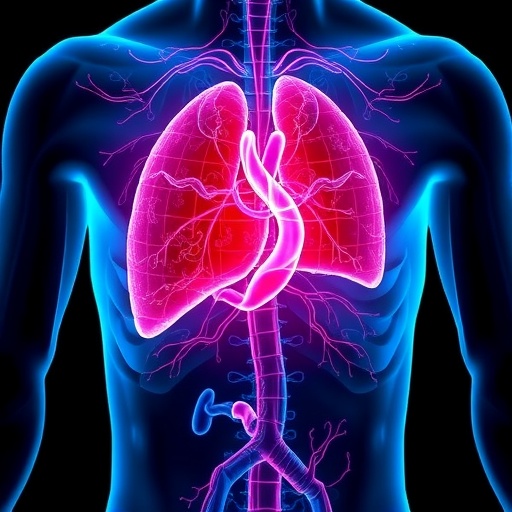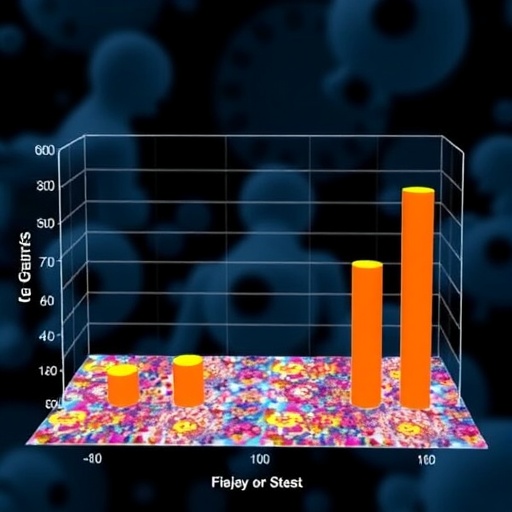In a groundbreaking study published in Nature Communications, researchers have unveiled a novel approach to combat vascular aging by targeting the metabolic pathways within endothelial cells. The study, led by Wu, Tan, Cheng et al., reveals that enhancing the cytosolic NADPH metabolism in these crucial cells can significantly ameliorate the detrimental effects of aging on blood vessels. This discovery not only deepens our understanding of vascular biology but also holds promising therapeutic potential for age-related cardiovascular diseases.
Vascular aging is a well-recognized contributor to a spectrum of cardiovascular disorders, which remain leading causes of morbidity and mortality worldwide. As arteries and capillaries age, they undergo structural alterations and functional decline, contributing to increased vascular stiffness, reduced vasodilation, and heightened susceptibility to inflammatory insults. Central to maintaining vascular integrity and function are endothelial cells, which line the interior surface of blood vessels and regulate crucial processes, including barrier function, inflammation, and hemostasis.
The metabolic state of endothelial cells is pivotal in dictating their physiology. Among the myriad metabolic cofactors, nicotinamide adenine dinucleotide phosphate (NADPH) stands out due to its role in redox homeostasis, biosynthetic reactions, and cellular defense against oxidative stress. NADPH serves as a reducing equivalent in the regeneration of glutathione and thioredoxin, two critical antioxidant systems. Thus, the intracellular availability of NADPH directly influences the endothelial capacity to counteract reactive oxygen species (ROS), which are markedly increased during aging.
Wu and colleagues took an innovative approach by focusing on cytosolic NADPH metabolism, a compartment-specific aspect that has not been extensively explored in vascular aging research. Their work demonstrates that boosting this metabolic flux in endothelial cells results in enhanced antioxidant defenses, thereby mitigating oxidative damage and improving cellular function. Using advanced genetic and biochemical tools, the team manipulated key enzymes involved in NADPH production pathways, such as glucose-6-phosphate dehydrogenase (G6PD), which catalyzes the rate-limiting step of the pentose phosphate pathway—an essential NADPH generating route.
One of the critical insights from the study is the identification of a decline in cytosolic NADPH levels as a hallmark of endothelial aging. This depletion predisposes cells to oxidative stress and inflammation, initiating a cascade of harmful events that compromise vascular health. The researchers observed that restoring NADPH levels through metabolic interventions or gene modulation could reverse many signs of endothelial dysfunction. This includes improved nitric oxide (NO) bioavailability, reduced expression of inflammatory markers, and enhanced cellular resilience.
The implications of these findings extend beyond molecular biology into clinical relevance. By pinpointing cytosolic NADPH metabolism as a therapeutic target, the research opens avenues for drug development aimed at rejuvenating aging blood vessels. Pharmacological agents that enhance NADPH synthesis or mimic its actions could serve as potential therapeutics to prevent or delay vascular aging and its associated diseases, such as atherosclerosis, hypertension, and stroke.
Moreover, the study highlights the intricate interplay between metabolic pathways and vascular health, underscoring the importance of cellular metabolism as a determinant of aging. This perspective shifts the traditional view, which primarily focused on mechanical factors and systemic inflammation, towards a more nuanced understanding incorporating endothelial bioenergetics and redox balance as key modulators.
The authors employed state-of-the-art imaging techniques and functional assays to meticulously analyze endothelial function in aged animal models following NADPH metabolism enhancement. These comprehensive assessments revealed a remarkable restoration of vascular elasticity and responsiveness to vasodilatory stimuli, signaling a rejuvenation of endothelial health. Such improvements are critical since impaired vasodilation is a well-known contributor to hypertension and subsequent cardiovascular events.
Interestingly, the study also touches upon the potential systemic benefits of augmenting endothelial NADPH metabolism. Improved endothelial health can favorably influence overall circulatory dynamics and may attenuate the progression of age-related metabolic disorders, which often share common pathophysiological pillars such as oxidative stress and inflammation. Thus, the impact of this intervention could have far-reaching consequences beyond the vascular system alone.
The mechanistic depth of the research delves into the molecular signaling pathways downstream of NADPH modulation. The investigators elucidate how enhanced NADPH production stabilizes endothelial nitric oxide synthase (eNOS), preventing its uncoupling—a phenomenon frequently observed in aging vessels that leads to superoxide generation rather than NO production. By preserving eNOS function, the cells maintain proper vascular tone and inhibit pro-inflammatory signaling, showcasing a direct link between metabolism and endothelial homeostasis.
Furthermore, the team investigated how augmented NADPH metabolism influences mitochondrial function within endothelial cells. Mitochondrial health is intricately connected to cellular aging, and the data suggest that cytosolic NADPH elevation supports mitochondrial integrity by limiting oxidative damage and preserving mitochondrial bioenergetics. This dual improvement in cytosolic and mitochondrial metabolism represents a comprehensive strategy to prolong endothelial viability and function.
Translational aspects of the research were addressed by examining the effects of metabolic enhancement in aged human endothelial cells in vitro. These experiments confirmed that the metabolic interventions confer similar protective effects as seen in animal models, bolstering the potential for clinical application. However, the authors caution that further studies are needed to fully understand the long-term safety and efficacy of manipulating NADPH pathways in humans.
The findings contribute to the burgeoning field of metabolic reprogramming as a therapeutic principle in aging-related diseases. While previous therapies targeting oxidative stress broadly have met with limited success, the current research offers a targeted, mechanistic approach that enhances endogenous antioxidant capacity through metabolic means rather than simply scavenging free radicals.
Critically, the study emphasizes the need for precision medicine strategies in cardiovascular aging. The metabolic heterogeneity of endothelial cells across different vascular beds suggests that tailored approaches may be necessary to achieve maximal benefit. Future research may focus on developing tissue-specific modulators of NADPH metabolism to optimize therapeutic outcomes.
In conclusion, this seminal work by Wu, Tan, Cheng et al. elucidates a previously underappreciated metabolic vulnerability in aging endothelial cells and presents a compelling case for elevating cytosolic NADPH metabolism as a viable strategy to mitigate vascular aging. By integrating metabolic biochemistry with vascular physiology, the study paves the way for innovative interventions that could transform the management of cardiovascular aging and associated pathologies.
As the global population ages, the burden of vascular aging and its sequelae will escalate, underscoring the importance of such pioneering research. The prospect of rejuvenating blood vessels through metabolic modulation heralds a new era in cardiovascular medicine, where reprogramming cellular metabolism might unlock the secrets to prolonged vascular health and longevity.
Subject of Research: Vascular aging and endothelial cell metabolism.
Article Title: Elevating cytosolic NADPH metabolism in endothelial cells ameliorates vascular aging.
Article References:
Wu, D., Tan, B., Cheng, Z. et al. Elevating cytosolic NADPH metabolism in endothelial cells ameliorates vascular aging. Nat Commun 16, 9667 (2025). https://doi.org/10.1038/s41467-025-64652-z
Image Credits: AI Generated
DOI: https://doi.org/10.1038/s41467-025-64652-z
Tags: aging effects on endothelial cellsendothelial cell metabolism and cardiovascular healthimproving blood vessel health through metabolisminflammatory responses in vascular agingNADPH metabolism and vascular agingnicotinamide adenine dinucleotide phosphate benefitsoxidative stress and vascular functionredox homeostasis in aging blood vesselsstrategies to combat vascular agingtherapeutic potential for age-related vascular diseasesunderstanding vascular biology and agingvascular stiffness and cardiovascular disorders





